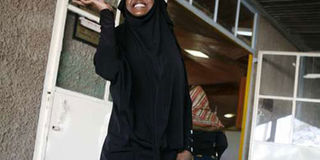Accepting girls in hijab in church-funded school is acknowledgement of diversity of faith

A girl in a hijab in Nairobi in Nairobi during World Hijab Day celebrations on February 1, 2015. PHOTO | EVANS HABIL | NATION MEDIA GROUP
What you need to know:
Article 32 (4) of Constitution states that a person shall not be compelled to act or engage in any act that is contrary to the person’s beliefs or religion.
As Court of Appeal rightly noted, fundamental rights cannot be taken away at the altar of education.
The Court of Appeal recently ruled that preventing Muslim girls from wearing hijab in church-sponsored schools violated the Constitution. The court also directed the Education directorate to ensure the creation of new rules on school uniforms and not to discriminate against students based on religion,
The decision touches on the right to freedom of conscience, religion, belief, and opinion and the right to freedom of expression, as guaranteed in Articles 32 and 33 respectively of the Constitution.
The dispute in the appeal that led to this decision was that those opposed to wearing the prescribed school uniform were free to transfer to other schools where their dress code was allowed. It was further argued that allowing Muslim girls to wear hijab and white trousers amounted to special treatment.
While the standardisation of school uniform is important, such rules should be cognisant of certain exemptions and diversity in our country.
Kenya is a country of many religions and inhibiting citizens’ fulfilment of other rights as a result of their religion is undesirable, retrogressive, and divisive.
Accepting girls in hijab and white pants as students in a church-funded school is an essential acknowledgement of the diversity of faith among Kenyans. Wearing a hijab should not be seen as religious rebellion but rather the acceptance that our identities can be complex and multiple.
PERSON’S BELIEFS
Article 32 (4) of the Constitution states that a person shall not be compelled to act or engage in any act that is contrary to the person’s beliefs or religion. As the court rightly noted, fundamental rights cannot be taken away at the altar of education. Rightly so, students do not abandon their constitutional rights when they enter the school, therefore their choices about their appearance, especially regarding their religious convictions, must be protected.
Defending school girls’ right to express themselves by wearing hijab is also a defence of their right to free expression regarding their spirituality.
Inter-religious dialogue is an integral element of the socialisation process. Because of the appellate judges’ decision, students will now interact freely, knowing that discrimination on the basis of one’s faith is not permitted.
The prescription of the hijab for Muslim students will aid in breaking the undignified stereotypes and prejudices that Islam has been illogically associated with. Few Kenyans care to know or acknowledge that Islam was being practised in the region decades before any European missionaries landed on eastern Africa soil to spread Christianity.
We should be aware of the predominant narrative that headscarves are a misogynist symbol of purity in a culture that segregates, subordinates, silences, prejudices, and forces women and girls into second-class citizen status. On the contrary, constitutionally speaking, women have a right to wear – or not wear – the headscarf.
BURKINI DEBATE
This decision comes at a time when the debate about the burkini rages in France. In the burkini case, the debate has morphed into an even bigger discussion about the place of Islam in France’s staunchly secular culture.
In both the Kenyan and the French cases, there are compelling cases for exemptions from seemingly inflexible policies of uniformity. Just as it has now been done in Kenya, one by one, French courts have overturned the ban on the burkini in about 30 French towns.
It is important for non-Muslims to stop seeing the hijab as a sign of resistance to the secularisation of society, as in countries such as France and Belgium, where there have been attempts to ban face veils.
Conversely, there have been developments in some parts of the world in trying to find an amenable solution to this issue.
In the United Kingdom, the Metropolitan Police (London) grants on-duty Muslim policewomen the option of wearing hijab in the colours of the force. Plainclothes female officers wear hijab of their choice.
In democracies such as the USA, the hijab has become a symbol of religious freedom as opposed to representing oppression. It is a way for Muslim women to express their beliefs.
With the landmark judgment, a practical expectation is that Muslim girls will be allowed to wear scarves in the respective school colours.
Demas Kiprono ([email protected]) and Churchill Ongere ([email protected]) work for Article 19 Eastern Africa.





